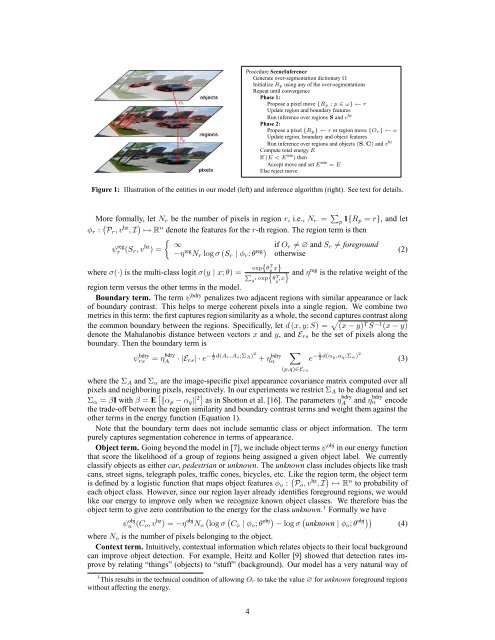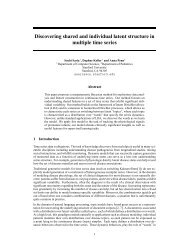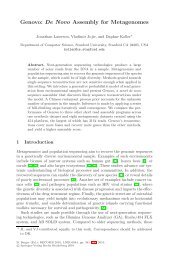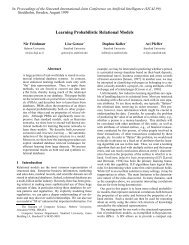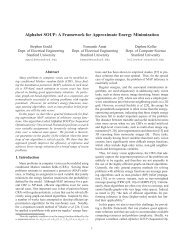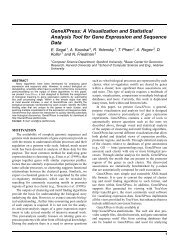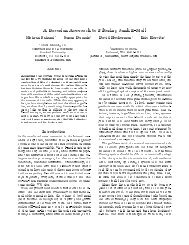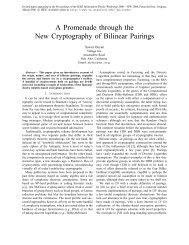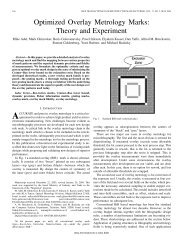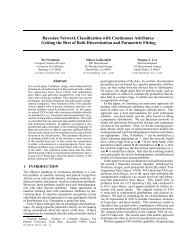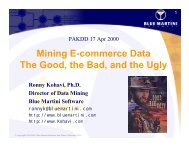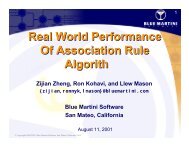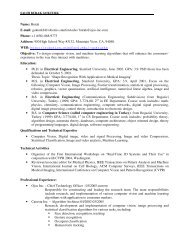Region-based Segmentation and Object Detection - Stanford ...
Region-based Segmentation and Object Detection - Stanford ...
Region-based Segmentation and Object Detection - Stanford ...
Create successful ePaper yourself
Turn your PDF publications into a flip-book with our unique Google optimized e-Paper software.
Procedure SceneInference<br />
Generate over-segmentation dictionary Ω<br />
Initialize Rp using any of the over-segmentations<br />
Repeat until convergence<br />
Phase 1:<br />
Propose a pixel move {Rp : p ∈ ω} ← r<br />
Update region <strong>and</strong> boundary features<br />
Run inference over regions S <strong>and</strong> v hz<br />
Phase 2:<br />
Propose a pixel {Rp} ← r or region move {Or} ← o<br />
Update region, boundary <strong>and</strong> object features<br />
Run inference over regions <strong>and</strong> objects (S,C) <strong>and</strong> v hz<br />
Compute total energy E<br />
If (E < E min ) then<br />
Accept move <strong>and</strong> set E min = E<br />
Else reject move<br />
Figure 1: Illustration of the entities in our model (left) <strong>and</strong> inference algorithm (right). See text for details.<br />
More formally, let Nr be the number of pixels in region r, i.e., Nr = <br />
p 1{Rp = r}, <strong>and</strong> let<br />
φr : Pr,v hz , I ↦→ R n denote the features for the r-th region. The region term is then<br />
ψ reg<br />
r (Sr,v hz ) =<br />
∞ if Or = ∅ <strong>and</strong> Sr = foreground<br />
−η reg Nr log σ (Sr | φr;θ reg ) otherwise<br />
where σ(·) is the multi-class logit σ(y | x;θ) = exp{θT y x}<br />
n<br />
P<br />
y<br />
′ exp<br />
θ T<br />
y ′x<br />
(2)<br />
o <strong>and</strong> η reg is the relative weight of the<br />
region term versus the other terms in the model.<br />
Boundary term. The term ψ bdry penalizes two adjacent regions with similar appearance or lack<br />
of boundary contrast. This helps to merge coherent pixels into a single region. We combine two<br />
metrics in this term: the first captures region similarity as a whole, the second captures contrast along<br />
the common boundary between the regions. Specifically, let d (x,y;S) = (x − y) T S −1 (x − y)<br />
denote the Mahalanobis distance between vectors x <strong>and</strong> y, <strong>and</strong> Ers be the set of pixels along the<br />
boundary. Then the boundary term is<br />
ψ bdry<br />
rs = η bdry<br />
A · |Ers|<br />
1 −<br />
· e 2 d(Ar,As;ΣA)2<br />
+ η bdry<br />
α<br />
<br />
(p,q)∈Ers<br />
1 −<br />
e 2 d(αp,αq;Σα)2<br />
where the ΣA <strong>and</strong> Σα are the image-specific pixel appearance covariance matrix computed over all<br />
pixels <strong>and</strong> neighboring pixels, respectively. In our experiments we restrict ΣA to be diagonal <strong>and</strong> set<br />
Σα = βI with β = E αp − αq2 as in Shotton et al. [16]. The parameters η bdry<br />
A <strong>and</strong> ηbdry α encode<br />
the trade-off between the region similarity <strong>and</strong> boundary contrast terms <strong>and</strong> weight them against the<br />
other terms in the energy function (Equation 1).<br />
Note that the boundary term does not include semantic class or object information. The term<br />
purely captures segmentation coherence in terms of appearance.<br />
<strong>Object</strong> term. Going beyond the model in [7], we include object terms ψobj in our energy function<br />
that score the likelihood of a group of regions being assigned a given object label. We currently<br />
classify objects as either car, pedestrian or unknown. The unknown class includes objects like trash<br />
cans, street signs, telegraph poles, traffic cones, bicycles, etc. Like the region term, the object term<br />
is defined by a logistic function that maps object features φo : Po,v hz , I ↦→ Rn to probability of<br />
each object class. However, since our region layer already identifies foreground regions, we would<br />
like our energy to improve only when we recognize known object classes. We therefore bias the<br />
object term to give zero contribution to the energy for the class unknown. 1 Formally we have<br />
ψ obj<br />
n (Co,v hz ) = −η obj <br />
No log σ Co | φo;θ obj − log σ unknown | φo;θ obj<br />
(4)<br />
where No is the number of pixels belonging to the object.<br />
Context term. Intuitively, contextual information which relates objects to their local background<br />
can improve object detection. For example, Heitz <strong>and</strong> Koller [9] showed that detection rates improve<br />
by relating “things” (objects) to “stuff” (background). Our model has a very natural way of<br />
1 This results in the technical condition of allowing Or to take the value ∅ for unknown foreground regions<br />
without affecting the energy.<br />
4<br />
(3)


